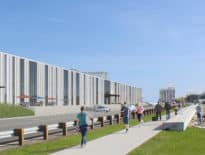There are two ways to look at the two-hour delays and blocks-long crowds at North Station following last week’s Rolling Rally: a debacle proving Commuter Rail operator Keolis can’t even be trusted to operate a child’s toy train set, or a resounding victory for public transit. We think Boston’s real estate community should lean towards the latter, and see the potential value a better-funded, more frequent system could unlock.
The Boston Police Department estimates 1.5 million people came to watch Gronk, Brady and the rest of the Patriots ride their duck boat chariots in a confetti-dusted triumphal march that would have made Julius Caesar jealous. Over 100,000 of those celebrants came in via Commuter Rail – Keolis spokesperson Justin Thompson wrote in an email that “all indications suggest ridership was the highest ever at more than double a typical daily passenger level.”
The previous record – 225,000 – was set Oct. 31 last year, when Red Sox fans filled Boston’s streets for another championship celebration and Halloween fans headed to and from Salem. Typically, the system transports 127,000 people on weekdays, he wrote.
To handle the influx Keolis laid on an extra 16 trains in the morning (enough to handle 25,000 more riders) and 14 more after the parades after it became clear the crowds were bigger than the system had ever seen, Thompson said – those 30 trains were all Keolis had available.
The crowds waiting for trains after Tuesday’s rally – thousands who, without much prompting from public officials, saw the train as a better way to get around that day than a car – prove industry leaders should be paying close attention to the MBTA’s efforts to map out a future for the Commuter Rail system. The future of Massachusetts’ economy and its ability to cut greenhouse gas emissions depends on it.
After months of research, the MBTA’s Rail Vision Advisory Committee unveiled seven options for improving the system two weeks ago, and is surveying the public on the options at mbtarailvisionsurvey.com. All require significant public investment, but only a few would get Greater Boston where it needs to go.
At the low end, the first option would do little more than buff the status quo by trying to improve on-time performance and go forward with the South Coast Rail expansion and move to trains running every 30 to 60 minutes.
The most elaborate option would see full electrification of the system, the establishment of “key stations” where trains will stop more frequently and offer service almost as frequent as a subway – every 15 minutes.
The MBTA’s committee won’t make the final decisions, but its recommendations will set the terms of the debate on what the bones of our future mass transit system will look like. Will our leaders pick a penny-wise, pound-foolish system in the grand tradition of many Massachusetts infrastructure investments, or will they pick a system that is fast and frequent enough to replace car commuting for the region’s millions of workers, and the hundreds of thousands more expected to join the workforce in the coming years? The state’s businesses must take steps to be a powerful voice in favor of the latter, either in public or in private.





